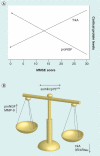Cholinergic system during the progression of Alzheimer's disease: therapeutic implications
- PMID: 18986241
- PMCID: PMC2631573
- DOI: 10.1586/14737175.8.11.1703
Cholinergic system during the progression of Alzheimer's disease: therapeutic implications
Abstract
Alzheimer's disease (AD) is characterized by a progressive phenotypic downregulation of markers within cholinergic basal forebrain (CBF) neurons, frank CBF cell loss and reduced cortical choline acetyltransferase activity associated with cognitive decline. Delaying CBF neurodegeneration or minimizing its consequences is the mechanism of action for most currently available drug treatments for cognitive dysfunction in AD. Growing evidence suggests that imbalances in the expression of NGF, its precursor proNGF and the high (TrkA) and low (p75(NTR)) affinity NGF receptors are crucial factors underlying CBF dysfunction in AD. Drugs that maintain a homeostatic balance between TrkA and p75(NTR) may slow the onset of AD. A NGF gene therapy trial reduced cognitive decline and stimulated cholinergic fiber growth in humans with mild AD. Drugs treating the multiple pathologies and clinical symptoms in AD (e.g., M1 cholinoceptor and/or galaninergic drugs) should be considered for a more comprehensive treatment approach for cholinergic dysfunction.
Figures

References
-
- Christensen DD. Alzheimer's disease: progress in the development of anti-amyloid disease-modifying therapies. CNS Spectr. 2007;12(2):113–116. 119–123. - PubMed
-
- Wimo A. Clinical and economic outcomes – friend or foe? Int. Psychogeriatr. 2007;19(3):497–507. - PubMed
-
- Petersen RC. Mild cognitive impairment as a diagnostic entity. J. Intern. Med. 2004;256(3):183–194. - PubMed
-
- Winblad B, Palmer K, Kivipelto M, et al. Mild cognitive impairment – beyond controversies, towards a consensus: report of the International Working Group on Mild Cognitive Impairment. J. Intern. Med. 2004;256(3):240–246. - PubMed
-
- Bennett DA, Schneider JA, Bienias JL, Evans DA, Wilson RS. Mild cognitive impairment is related to Alzheimer disease pathology and cerebral infarctions. Neurology. 2005;64(5):834–841. - PubMed
Publication types
MeSH terms
Substances
Grants and funding
- R01 AG010668/AG/NIA NIH HHS/United States
- R01 AG043375/AG/NIA NIH HHS/United States
- AG14449/AG/NIA NIH HHS/United States
- P01 AG009466/AG/NIA NIH HHS/United States
- AG26032/AG/NIA NIH HHS/United States
- AG09466/AG/NIA NIH HHS/United States
- AG10161/AG/NIA NIH HHS/United States
- AG10688/AG/NIA NIH HHS/United States
- P01 AG017617/AG/NIA NIH HHS/United States
- P30 AG010161/AG/NIA NIH HHS/United States
- P01 AG014449/AG/NIA NIH HHS/United States
- R21 AG026032/AG/NIA NIH HHS/United States
- P01 NS048447/NS/NINDS NIH HHS/United States
LinkOut - more resources
Full Text Sources
Other Literature Sources
Medical
Research Materials
